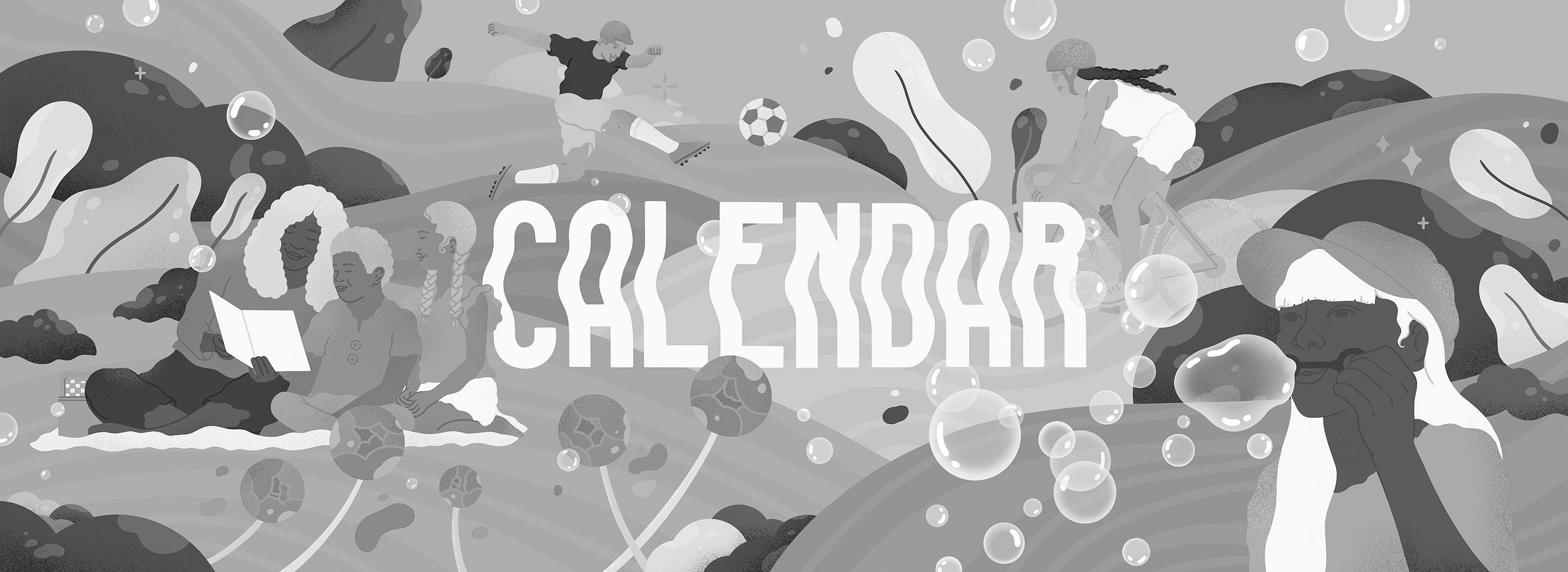




The South Side Weekly is an independent non-profit newspaper by and for the South Side of Chicago. We provide high-quality, critical arts and public interest coverage, and equip and develop journalists, artists, photographers, and mediamakers of all backgrounds.
Volume 10, Issue 4
Editor-in-Chief Jacqueline Serrato
Managing Editor Adam Przybyl
Senior Editors Christopher Good Olivia Stovicek Sam Stecklow Martha Bayne
Arts Editor Isabel Nieves
Education Editor Madeleine Parrish
Housing Editor Malik Jackson Community
Organizing Editor Chima Ikoro Immigration Editor Alma Campos
Contributing Editors Lucia Geng Matt Moore Francisco Ramírez Pinedo
Jocelyn Vega Scott Pemberton
Staff Writers Kiran Misra Yiwen Lu
Director of Fact Checking: Sky Patterson
Fact Checkers: Siri Chilukuri, Grace Del Vecchio, Lauren Doan, Ellie Gilbert-Bair, Christopher Good, Savannah Hugueley, Kate Linderman, Zoe Pharo and Emily Soto
Visuals Editor Bridget Killian
Deputy Visuals Editors Shane Tolentino Mell Montezuma
Staff Illustrators Mell Montezuma Shane Tolentino
Layout Editors Colleen Hogan Shane Tolentino Tony Zralka
Webmaster Pat Sier
Managing Director Jason Schumer
Director of Operations Brigid Maniates
The Weekly is produced by a mostly all-volunteer editorial staff and seeks contributions from across the city. We publish online weekly and
print every other Thursday.
Send submissions, story ideas, comments, or questions to editor@southsideweekly.com or mail to:
South Side Weekly 6100 S. Blackstone Ave. Chicago, IL 60637
For advertising inquiries, please contact: Susan Malone (773) 358-3129 or email: malone@southsideweekly.com
For general inquiries, please call: (773) 643-8533
IN CHICAGO
In covering immigration over the past year, I realized how the term immigration is far broader than I initially thought. What comes to mind for many is policy or what is happening at the border. While we often cover those things, there’s more to it. The story of immigration is the story of people who have come to Chicago from across the globe, whether recent arrivals or multi-generational families who live in the city’s communities. It’s the story of people fighting against racism and war while struggling for workers rights, LGBTQ rights, women’s rights, housing, and education equity—all which are issues of our time. And in the pursuit for human rights, Haitians, Nigerians, Mexicans, Chinese, Ukrainians, Venezuelans and others are connected.
That is why I’m excited to present this special issue. To understand what is happening in Ukraine, I interviewed Kimberly St. Julian-Varnon, a scholar on the Black experience, race, and ethnicity. I also talk to community groups who say long-term solutions are desperately needed for recent asylum seekers in Chicago. You will also find a short story taking place on the U.S.–Mexico border and a book review of Against the Wall, about a border agent-turned-immigrant activist, both written by Samuel du Bois. Matthew Murphy explores what’s behind the popular Chinese Shen Yun performance while Chima Ikoro and Chandrikah Rukh explore immigration and culture in The Exchange. There are also important explainers on how to help recent immigrants, sanctuary laws, and REAL ID.
If you have any pitches for stories, you can contact me at alma.campos@southsideweekly.com
Alma Campos Immigration editorCity ad dollars to be spent on independent media
On October 26, Mayor Lori Lightfoot signed an executive order designating that City of Chicago departments allocate at least fifty percent of their annual advertising budgets to community media outlets like the Weekly. This effort was led by the Chicago Independent Media Alliance (CIMA), their researcher (and Weekly senior editor) Sam Stecklow, and countless other advocates in local media. In October 2020, CIMA began replicating a study by the Center for Community Media at the City University of New York (CUNY). The New York City project produced a similar Executive Order that resulted in a multi-million dollar shift to community and ethnic media. Jhmira Alexander, President & Executive Director of Public Narrative, described the impact of this shift in Chicago’s own local media: “Chicago is a leader in hyperlocal journalism. This is a significant step for advancing equity of voice in Chicago and beyond. Agency marketing and advertising dollars will offer community media outlets the chance to increase their capacity for coverage and innovation in better serving the different communities in our diverse city.”
Naty’s Pizza in Gage Park charged with underpaying delivery drivers
city welcomes asylum seekers but their future is uncertain
Employees at many nonprofits are feeling swamped and say sustainable, long-term services are strongly needed.
alma campos
la ciudad recibe a solicitantes de asilo, pero su futuro es incierto
Los defensores de inmigrantes dicen que se necesita urgentemente financiación para el apoyo legal y de la vivienda.
4
by Bridget KillianFour South Side men have sued Naty’s Pizza in Gage Park over wage theft, according to multiple news reports. The delivery drivers, who worked at the location for several years, have said they were paid per delivery and classified as independent contractors when they should have been paid as employees. Asael Espinosa, Javier Castillo, Juan Rosales, and Santos Nava have claimed they were tasked with various other duties without pay, like cleaning bathrooms and stocking merchandise. Another issue was the owner, Abel Rodriguez, only provided them with daily gas reimbursements of $15, no matter how many miles they drove each day. Joined by family members at a press conference outside the restaurant last month, the workers hope to improve their working conditions and receive back pay, which could be in the tens of thousands of dollars. Rodriguez could not be reached for comment, though his daughter claimed the workers could have left if they didn’t like the contracts. The two other Naty’s locations in Chicago are owned by different people and unconnected to the lawsuit. The workers are being supported by Arise Chicago, a workers’ justice organization that helps workers recover owed compensation.
alma campos ............................................ 5
where to make donations for recently arrived immigrants
Chicago organizations are working to assist asylum seekers. ella beiser 6
dónde hacer donaciones para los inmigrantes recién llegados
Las organizaciones de Chicago están trabajando para ayudar los solicitantes de asilo. ella beiser 8
what makes chicago a welcoming city?
An overview of policies that make this an immigrant-friendly city.
sofia mcdowell 10
the troubled politics of shen yun
A highly political parent organization, an alt-right media empire, and a global power struggle over the narrative of Chinese history. matthew murphy ................................. 11
the exchange: immigration & culture
The Weekly’s poetry corner offers our thoughts in exchange for yours.
chima ikoro, chandrikah rukh ............ 12
the russo ukrainian war: what is happening?
An interview with Kimberly St. Julian-Varnon on Russian disinformation and race relations. alma campos
.......................................... 14
book review: against the wall
Jenn Budd’s memoir about her time in the U.S. Border Patrol reveals the agency as racist, sexist, lawless, and dishonorable.
samuel du bois 16
what real id will mean for undocumented chicagoans
Starting May 2023, undocumented immigrants may be barred from getting on domestic flights.
devin haas ............................................. 17
the paso del norte international bridge
A short story about how the U.S. Border Patrol lied to 149 migrants and delivered them back to Mexico.
samuel du bois 20 calendar Bulletin and events.
zoe pharo
Aftera media-frenzied welcome, thousands of asylum seekers from Latin America, particularly from Venezuela, have arrived in Chicago. Texas governor Greg Abbott has been sending migrants here and other welcoming cities, like Washington D.C. and New York City, to pressure President Joe Biden’s administration into enacting harsher border enforcement policies. As of October 27, 3,696 asylum seekers have arrived in Chicago.
Abbott said he will continue to bus asylum seekers to these cities until the federal government “does its job and secures the border.” However, local officials have complained that they have not been properly notified of new arrivals and there is no line of communication with Texas politicians. As a result, Chicago and other Democrat cities have been scrambling to coordinate relief efforts without the federal funds that border states receive to accommodate asylum seekers.
In press conferences, Mayor Lori Lightfoot has been outspoken about her support of migrants. The city has provided temporary housing at shelters and hotels, and connected migrants to support after their arrival at Greyhound’s Union Station. Upon arrival some of the migrants were sent to the Salvation Army in Humboldt Park. The City has also set up a web page where Chicagoans are encouraged to make donations via Amazon of items such as underwear, jogging pants, socks, sports bras, and other basic necessities.
Additionally, Juan Salgado, chancellor of the City Colleges of Chicago (CCC), in an special announcement email to the CCC community in mid-October, announced CCC has provided “a portion of Truman
College” on the city’s Northeast Side as a temporary shelter for new arrivals as well as a portion of the Arturo Velasquez Institute on the Southwest Side. In the email, Salgado said some CCC staff have volunteered to serve as translators and liaisons.
But employees at many nonprofits are feeling swamped and say sustainable, long-term services are strongly needed.
Juan Carlos Hernández, the immigration program coordinator at the Chicago Religious Leadership Network on Central America (CRLN), said legal support and housing are the most needed but hardest to get because it’s costly.
He said obtaining asylum isn’t just a matter of applying for it—nationally, around 60 percent of asylum cases are rejected. When their cases are rejected, “people…often end up disappearing… they end up living in the shadows as undocumented people making their lives here,” he said.
But CRLN doesn’t have the capacity to help with asylum cases, he said. They depend on partner organizations like the nonprofit Heartland Alliance’s National Immigrant Justice Center (NIJC), a project of pro-bono attorneys in Chicago, Indiana and beyond.
ManoLasya Parepa, a staff attorney with NIJC in Chicago, said she knows they’ve received some funding from the City but that more funding would be “great to get more staff and more people working on [cases].” Specifically, Parepa said there’s a shortage of attorneys and staff to support not only recent asylum seekers, but those that already live here.
22nd Ward Alderperson Michael Rodríguez, who represents parts of La Villita, a neighborhood that has been a port of entry for immigrant families for decades, said nonprofits are the ones taking the lead and they are not sufficiently supported with money from the City. Annually, La Villita
contributes $900 million to Chicago’s economy. “We need to make sure we’re meeting all of our needs. This obviously increased those needs and that contingency money should be going to nonprofits.”
Rodriguez was referring to funds the mayor promised to set aside for newly arrived immigrants during her budget address in October, where she proposed a $16.4 billion budget for 2023 to City Council. “Given the recent increase in the need for resources available to support migrants coming to Chicago,” Lightfoot said, “We have $5 million set aside for that work and other contingencies.”
Rodriguez said he just hopes this money will go to nonprofits in immigrant communities. And while he said the City will be applying for federal money, and that those nonprofits will be included in those applications, he’ll be watching the $5 million in contingency funds “like a hawk.” He also thinks it’s in the city’s self-interest to help asylum seekers. “At the end of the day, we’ve been losing population in the city… it’s not like we’re growing at the same rate as other big cities. So we need more people…”
and people of color have been disproportionately impacted by COVID-19. During its peak, they had a difficult time finding vaccines and accessing health information. That is why the Illinois Coalition for Immigrant and Refugee Rights (ICIRR) thinks long term, comprehensive solutions are needed.

“Already existing inequities were compounded by the pandemic for immigrants and all communities of color,” said Brandon Lee, Director of Communications for ICIRR. “We’re advocating for comprehensive and
Employees at many nonprofits are feeling swamped and say sustainable, long-term services are strongly needed.
sustainable long-term solutions that extend beyond thirty to sixty days. If the last couple of months have shown us anything, it’s that a high level of coordination between the city, state, and community organizations is sorely needed.”
Lee pointed to housing and education as the highest priority and said the reason why protections for immigrants are stronger and resources have grown over the years is because immigrant communities have demanded them in the first place. Immigrants have challenged racist laws, have urged politicians to fund services and put an end to family separations.
The mayor has also gotten pushback
about coordinating efforts from 20th Ward Alderperson Jeanette Taylor, according to the Hyde Park Herald. In a meeting with the mayor, Taylor learned that the City was considering housing asylum seekers in a vacant Woodlawn school. Taylor said there wasn’t proper notice given to her for community input. The alderwoman said she looked “for alternatives that will make this transition more comfortable” for new arrivals. And while the mayor decided against the move, Taylor pointed to the irony of how the City has turned the other way about displaced residents in Woodlawn. The Chicago Teachers Union is also urging the mayor to support immigrant
students, stating the arrival of asylum seekers has “intensified the equity gap that students in CPS already confront.” The union adds that students and their families “lack bilingual education programs, native language resources, culturally relevant curriculum, and ESL/Bilingual endorsed staff.”
When the Weekly pressed for details about the City’s overall coordinated efforts and plans moving forward, the Chicago Department of Family and Support Services Public Affairs Director never got back for an interview.
“For the last couple of weeks, it’s been at the front page,” said Rodriguez. “And you know…I think people are going to
start forgetting about this. And I’m really worried about that.”
In September, Governor J.B Pritzker issued a disaster proclamation to accelerate the availability of state funds and resources to manage the situation. Additionally, the City Council's Latino Caucus urged the mayor to declare a state of emergency on October 12—just a week after New York City’s mayor Eric Adams declared a state of emergency as more immigrants are expected to arrive. ¬
Alma Campos is the Weekly’s Immigration editor.
Los empleados de muchas organizaciones sin fines de lucro se sienten agobiados y dicen que se necesitan servicios sostenibles y a largo plazo.
POR ALMA CAMPOSMilesde inmigrantes procedentes de América Latina, especialmente de Venezuela, han llegado a Chicago entre mucha atención mediática. El gobernador de Texas, Greg Abbott, ha estado enviando a migrantes aquí y a otras ciudades acogedoras, como Washington D.C. y la Ciudad de Nueva York, para presionar a la administración del Presidente Joe Biden a que adopte políticas fronterizas más severas. 3,696 migrantes han llegado a Chicago hasta finales de octubre, según datos.
Abbott dijo que seguirá enviando solicitantes de asilo a estas ciudades hasta que el gobierno federal “haga su trabajo y asegure la frontera”. Pero funcionarios locales se han quejado de que no han sido adecuadamente notificados de la llegada de migrantes ni hay comunicación con los políticos de Texas. Como resultado, Chicago y otras ciudades demócratas se han movilizado para coordinar los servicios de ayuda sin los fondos federales que los
estados fronterizos suelen obtener para recibir a los solicitantes de asilo.
En las conferencias de prensa, la alcaldesa Lori Lightfoot ha expresado su apoyo a los solicitantes de asilo. La ciudad ha proporcionado alojamiento temporal en albergues y hoteles, y ha puesto en contacto a los inmigrantes con ayudas tras su llegada a la estación Union Station del Greyhound. La Municipalidad también ha creado una página web en la que invita a los habitantes de Chicago a hacer donaciones a través de Amazon para artículos como ropa interior, pantalones, calcetines, brasieres deportivos y otras necesidades básicas.
Además, Juan Salgado, rector de City Colleges de Chicago (CCC), anunció en un correo electrónico especial al personal de CCC a mediados de octubre que CCC ha proporcionado “una parte del Truman College” en el lado noreste de la ciudad como refugio temporal para los recién llegados, así como una parte del Instituto Arturo Velásquez en el lado suroeste. En el correo electrónico,
Salgado dijo que algunos miembros del personal de CCC se han ofrecido para servir como traductores y aliados.
Pero los empleados de muchas organizaciones que ayudan a los inmigrantes se sienten agobiados y dicen que se necesitan servicios sostenibles y a largo plazo. Juan Carlos Hernández, coordinador del programa de inmigración de la Red de Líderes Religiosos de Chicago para Latinoamérica (CRLN, por sus siglas en inglés), dijo que el apoyo legal y el alojamiento son los más necesarios, pero los más difíciles de conseguir porque son costosos.
También dijo que obtener asilo no es sólo cuestión de solicitarlo: a nivel nacional, alrededor del 60% de los casos de asilo son rechazados. Cuando sus casos son rechazados, “la gente... suele desaparecer… acaban viviendo en las sombras como indocumentados haciendo su vida aquí”, dijo.
Pero la CRLN no tiene la capacidad de ayudar con los casos de asilo, dijo. Dependen de organizaciones asociadas
como el Centro Nacional de Justicia para Inmigrantes (NIJC, por sus siglas en inglés) de Heartland Alliance, un proyecto de abogados gratuitos en Chicago, Indiana y otros lugares.
ManoLasya Parepa, una abogada del NIJC en Chicago, dijo que sabe que han recibido algunos fondos municipales, pero que más fondos serían “beneficiosos para conseguir más personal y más gente trabajando en [los casos]”. En concreto, Parepa dijo que hay una escasez de abogados y personal para apoyar no sólo a los solicitantes de asilo recientes, sino también a los que ya viven aquí también.
El concejal del distrito 22, Michael Rodríguez, que representa a partes de La Villita, un barrio que ha sido un puerto de entrada para muchas familias de inmigrantes durante décadas, dijo que las organizaciones comunitarias son las que han tomado la iniciativa y que no son suficientemente apoyadas con dinero por parte de la Municipalidad. Anualmente,
La Villita aporta $900 millones a la economía de Chicago. “Tenemos que asegurarnos de que estamos atendiendo todas las necesidades. Obviamente, esto aumentó esas necesidades y ese dinero para imprevistos debería ir a las organizaciones sin fines de lucro”.
Rodríguez se refiere a los fondos que la alcaldesa prometió reservar para los inmigrantes recién llegados durante su presentación del presupuesto en octubre, donde propuso al Ayuntamiento un presupuesto de $16.4 mil millones para 2023. “Dado el reciente aumento en la necesidad de recursos disponibles para apoyar a los inmigrantes que llegan a Chicago”, dijo Lightfoot, “tenemos 5 millones de dólares reservados para ese trabajo y otras contingencias”.
Rodríguez dijo que sólo espera que este dinero se destine a las organizaciones sin fines de lucro en las comunidades inmigrantes. Y aunque dijo que la Muncipalidad solicitará dinero federal, y que esas organizaciones se incluirán en esas solicitudes, vigilará los $5 millones de dólares de fondos de contingencia “como un halcón”. También cree que debería ser de interés para la ciudad ayudar a los solicitantes de asilo. "A fin de cuentas, hemos estado perdiendo población en la ciudad... no estamos creciendo al mismo ritmo que otras grandes ciudades. Así que necesitamos más gente…”
Los inmigrantes y las personas de color se han visto afectados de forma desproporcionada por el COVID-19. Durante su pico, ellos tuvieron dificultades para encontrar vacunas y acceder a información crucial. Por ello, la Coalición de Illinois por los Derechos de los Inmigrantes y los Refugiados (ICIRR, por sus siglas en inglés) considera que se necesitan soluciones integrales a largo plazo. “Las desigualdades ya existentes se vieron agravadas por la pandemia para los inmigrantes y todas las comunidades de color”, dijo Brandon Lee, Director de Comunicaciones de ICIRR. "Abogamos por soluciones integrales y sostenibles a largo plazo que vayan más allá de treinta o sesenta días. Si los dos últimos meses nos han demostrado algo, es que es muy necesario un alto nivel de coordinación entre la ciudad, el estado y las organizaciones comunitarias.”
Lee señaló que la vivienda y la educación son la máxima prioridad y dijo
que la razón por la que hay más protecciones para los inmigrantes y los recursos han aumentado es porque las comunidades de inmigrantes las han exigido.
La alcaldesa también ha recibido críticas sobre la coordinación de sus esfuerzos por parte de la concejal del distrito 20, Jeanette Taylor, según el Hyde Park Herald. En una reunión con la alcaldesa, Taylor se enteró de que la ciudad quería albergar a los recién llegados en una escuela vacía de Woodlawn. Taylor dijo que no se le avisó debidamente para que la comunidad aportara su opinión.
La concejal dijo que buscó “alternativas que hicieran esta transición más cómoda” para los recién llegados. Y aunque la alcaldesa decidió en contra de la medida, Taylor señaló la ironía de cómo la Municipalidad les ha dado la espalda a los residentes desplazados en Woodlawn.
El Sindicato de Maestros de Chicago (CTU, por sus siglas en inglés) también insta a la alcaldesa a que apoye a los estudiantes inmigrantes, afirmando que la llegada de solicitantes de asilo ha “intensificado la brecha de equidad que ya enfrentan los estudiantes de CPS”. El sindicato añadió que los estudiantes y sus familias “carecen de programas de educación bilingüe, recursos lingüísticos nativos, currículo culturalmente relevante y personal de Inglés como segundo lenguaje (ESL) y bilingüe.”
Cuando el Weekly insistió varias veces en obtener detalles sobre los esfuerzos coordinados de la Municipalidad en general y los planes para el futuro, el Director de Asuntos Públicos del Departamento de Servicios Familiares y de Apoyo nunca respondió para dar una entrevista.
“Durante las pasadas dos semanas, esto ha estado en la portada”, dijo Rodríguez. “Y...creo que la gente va a empezar a olvidarse de esto. Y eso me preocupa mucho”.
En septiembre, el gobernador J.B. Pritzker emitió una proclamación de desastre para acelerar la disponibilidad de fondos y recursos estatales para manejar la situación. Además, el Caucus Latino del Concejo Municipal instó a la alcaldesa a declarar un estado de emergencia el 12 de octubre, solo una semana después de que el alcalde de la ciudad de Nueva York, Eric Adams, declarara un estado de emergencia a la espera de más migrantes. ¬
Alma Campos es editora de Inmigración para el Weekly.
Overthe past few months, hundreds of immigrants seeking asylum have been bussed from Texas to welcoming cities like New York, Washington, D.C. and Chicago under misleading circumstances, in what many Democrats have described as a political stunt by Texas Governor Greg Abbott and other Republicans. Many of the passengers are Venezuelans fleeing poverty and political instability.
Abbott has stated that he will continue to send migrants to welcoming cities until the Biden administration secures the southern border and acknowledges the “historic crisis” Texas is facing. In Chicago, the Welcoming City Ordinance guarantees the City will not inquire about immigration status, share that information with authorities or deny services based on immigration status.
As of October 15, over 3,667 asylumseekers have arrived by bus to Chicago. Mayor Lori Lightfoot has promised to assist them in accessing essential services.
Several legal organizations in Chicago are working to help immigrants apply for asylum, since they must wait six months after submitting their application before they can legally work in the United States. In the meantime, food, clothing and legal services are needed.
Below are several organizations and community groups working to distribute these services, many of which are on the South Side. Here’s how to help and get help for someone that may need it.
Cook County Health provides care for over 300,000 patients annually, forty-five percent of which are uninsured. Right now, the organization is helping recent asylum seekers meet their immediate needs. They are seeking donations of any size so that they can purchase clothing, personal hygiene products, and baby and school supplies.
Visit: cchealthfoundation.org. Call: (847) 818-2860
Organizations have been working to offer resources for newly arrived immigrants. Here’s a list of ways you can help.
Community Health provides primary care and specialty care, medication, lab testing, mental health services and health education at no cost to low-income and uninsured adults. Over 1,000 people volunteer every year, making it one of the largest volunteer-based health care centers in the country. At the moment they are seeking primary or specialty care providers for evenings and weekends. Community Health is a 501(c)3 charitable organization, and donations fund over ninety-five percent of their operations.
Multiple locations and hours, full details at communityhealth.org. Call: (773) 395-9900.
A number of Chicago alderpersons have opened their offices for dropoff donations. Food and used items are not accepted at the moment. A list of acceptable donations and dropoff locations can be found below. The City of Chicago is also connecting people interested in volunteering with appropriate organizations through this webpage: chicago.gov/city/en/sites/texasnew-arrivals/home.html.

The Pilsen Food Pantry supplies healthy and culturally appropriate food and clothes from their food pantry and clothes closet. They are currently seeking bags of rice, cooking oil, instant coffee, menstrual products, hygiene items, baby supplies and dry pet food. They also have volunteer opportunities including pantry shopping, delivery, unpacking and food
rescue (the collection of food that would otherwise go to waste at food-selling venues), as well as clothes sorting for the clothes closet. Sign up and information about available shifts can be found at volunteer-pilsenfoodpantry.as.me. 1850 S. Throop Street. Chicago, IL 60608. Donations can be dropped off from 10:30 am–1 pm on Sunday and 9:30 am–2:30 pm Monday to Wednesday and Friday. For more information, visit: figueroawufamilyfoundation.com, email pilsenfoodpantry.info@gmail.com or call (773) 812-3150.
The Instituto del Progreso Latino (IDL) is an organization that assists Latinx immigrants in accessing education, training and employment. IDL is seeking contributions to their Texas Immigrant Rapid Response Wishlist to support the basic needs of newly arrived families. The organization is seeking volunteers to assist with job readiness and digital literacy, as well as attorneys and third year law
students. There are additional opportunities for high school and college students. Visit: www.institutochicago.org. Call: (773) 890-0055
The Illinois Coalition for Immigrant and Refugee Rights (ICIRR) is an organization aimed at supporting immigrants and refugees in their integration into daily life. Founded in 1986, ICIRR has helped more than 100,000 immigrants apply for citizenship, has succeeded in advocating for numerous pro-immigrant bills, and led the charge for expanded healthcare options for immigrants in Illinois. Volunteers can register new U.S. citizens to vote after oath ceremonies. Immigrants can learn more about the citizenship process by contacting Marilu Moreno at mmoreno@icirr.org.
Email: volunteer@icirr.org. Visit: https:// www.icirr.org/volunteer
The Erie Neighborhood House has provided social services to meet the complex needs of immigrant and lowincome communities since its opening in 1870. The organization, which operates several centers across the city, offers youth programming, mental health resources, adult education and training, and legal services. The Erie Neighborhood House has volunteer opportunities to work with children, youth and adults as a homework helper, mentor, health promoter, and more. Multiple locations and hours. Visit: eriehouse. org. Email: volunteer@eriehouse.org
The Southwest Collective encompasses groups on the Southwest Side of Chicago tackling food equity and distributing baby supplies to young families. The group is currently seeking support through donations and volunteers for their events. Southwest Collective hosts monthly Freebies for Families where parents can donate or receive gently used baby items. The next Freebies for Families will be held on November 19 from noon to 2pm. The location will be announced closer to the event.
Visit: www.swcollective.org/support. Call: (708) 740-8914
Centro Romero is a community organization serving immigrant and refugee families on the Northeast Side of Chicago. They provide youth services, adult education, legal services and family programming to help families acclimate to the city and improve their opportunities for upward mobility. The center is looking for donations and volunteers to assist with their programming.
6126 N. Clark St. Open 9am–5pm Monday–Friday, 10am–4pm Saturday. Email: info@centroromero.org. Call: (773) 508-5300

The Brighton Park Neighborhood Council is a grassroots organization that provides school and community based services to address issues such as economic justice, immigrant justice, and economic justice. Their immigrant welcome center provides families with a case manager to assist with accessing financial services, education, job opportunities and legal services.
4477 S. Archer Ave. Open 9am–5pm Monday–Friday. Visit: bpncchicago.org/ volunteers.
Email: communications@bpncchicago.org. Call: (773) 523-7110. ¬
Ella Beiser is a lifelong Hyde Parker and is currently a sophomore at Bates College studying politics and digital and computational studies. In her free time she enjoys writing for her school newspaper and sharing music with friends.
Enmeses recientes, cientos de inmigrantes en busca de asilo han sido trasladados en autobús de Texas a ciudades acogedoras como Nueva York, Washington D.C. y Chicago bajo circunstancias engañosas, lo que muchos demócratas han descrito como una maniobra política del gobernador de Texas, Greg Abbott, y otros republicanos. Muchos de los pasajeros son venezolanos que huyen de la pobreza y la inestabilidad política.
Abbott ha declarado que seguirá enviando inmigrantes a las ciudades santuario hasta que el gobierno de Biden asegure la frontera sur y reconozca la "crisis histórica" a la que se enfrenta Texas. En Chicago, la Ordenanza de Ciudades Acogedoras garantiza que las autoridades locales no preguntarán por el estatus migratorio, ni compartirá esa información con las autoridades federales, ni les negará servicios a personas basándose en su estatus migratorio.
Hasta el 15 de octubre, más de 3,667 solicitantes de asilo han llegado en autobús a Chicago. La alcaldesa Lori Lightfoot ha prometido ayudarles a acceder a los servicios esenciales. Varias organizaciones legales en Chicago están trabajando para ayudar a los inmigrantes a solicitar asilo, ya que deben esperar seis meses después de presentar su solicitud para poder trabajar legalmente en Estados Unidos. Mientras tanto, se necesitan alimentos, ropa y servicios legales.
A continuación hay varias organizaciones y grupos comunitarios que
trabajan para distribuir estos servicios, muchos de los cuales están en el lado sur. Aquí se explica cómo ayudar y conseguir ayuda para alguien que pueda necesitarla.
Cook County Health atiende a más de 300,000 pacientes al año, el 45% de los cuales no tienen seguro médico. En este momento, la organización está ayudando a los solicitantes de asilo recientes a satisfacer sus necesidades inmediatas. Buscan donaciones de cualquier cantidad para poder comprar ropa, productos de higiene personal y materiales escolares y para bebés.
Visite cchealthfoundation.org. Llame al (847) 818-2860
Community Health ofrece atención médica y especializada, medicamentos, pruebas de laboratorio, servicios de salud mental y educación de la salud sin costo alguno a adultos de bajos ingresos y sin seguro médico. Más de 1,000 personas son voluntarias cada año, lo que lo convierte en uno de los mayores centros de atención de salud voluntarios del país. En este momento están buscando proveedores de atención médica o especializada para las tardes y los fines de semana. Community Health es una organización sin fines de lucro, y las donaciones financian más del 95% de sus operaciones.
Varias ubicaciones y horarios, visite communityhealth.org. Llame al (773) 3959900.
Varios concejales de Chicago han abierto sus oficinas para aceptar donaciones. Por el momento no se aceptan alimentos ni artículos usados. A continuación se incluye una lista de donaciones aceptables y lugares de entrega. La Ciudad de Chicago también está poniendo en contacto a las personas interesadas en ser voluntarios con las organizaciones adecuadas a través de este formulario: chicago.gov/city/en/sites/texas-newarrivals/home.html
Despensa de Comida de Pilsen
La Pilsen Food Pantry suministra alimentos saludables y culturalmente apropiados y ropa desde su despensa de alimentos y su armario de ropa. Actualmente buscan bolsas de arroz, aceite de cocina, café instantáneo, productos menstruales, artículos de higiene, artículos para bebés y comida seca para mascotas. También tienen oportunidades de voluntariado que incluyen la compra de los productos de despensa, la entrega, el desempaque y el rescate de alimentos (recoger alimentos que normalmente se desperdiciarían en los lugares donde se venden), así como la organización de ropa donada.
1850 S. Throop Street. Chicago, IL 60608. Visite figueroawufamilyfoundation.com, email a pilsenfoodpantry.info@gmail.com, o llame al (773) 812-3150. Para inscribirse a los turnos disponibles visite volunteerpilsenfoodpantry.as.me. Puede dejar donaciones 10:30 am–1 pm los domingos y 9:30 am–2:30 pm los lunes, martes, miércoles y viernes.
El Instituto del Progreso Latino (IDL) es una organización que ayuda a los inmigrantes latinos a acceder a la educación, capacitación y empleo. El IDL está buscando contribuciones para su Lista de Respuesta Rápida para Inmigrantes de Texas para apoyar las necesidades básicas de las familias recién llegadas. La organización está buscando voluntarios para ayudar con la preparación de empleo y la capacitación digital, así como abogados y estudiantes de abogacía de tercer año. Hay oportunidades adicionales para estudiantes de secundaria y universitarios.
Visite www.institutochicago.org. Llame al (773) 890-0055
Coalición de Illinois por los Derechos de Los Inmigrantes y Refugiados
La Coalición de Illinois por los Derechos de Los Inmigrantes y Refugiados (ICIRR, por sus siglas en inglés) es una organización destinada a apoyar a los
Dónde hacer donaciones para los inmigrantes recién llegados Las organizaciones han estado trabajando para ofrecer recursos a los inmigrantes recién llegados. Aquí está una lista de formas cómo ayudar.
inmigrantes y refugiados a integrarse a la vida cotidiana en el país. Fundada en 1986, ICIRR ha ayudado a más de 100,000 inmigrantes a solicitar la ciudadanía, ha conseguido abogar por numerosos proyectos de ley a favor de los inmigrantes y ha liderado la lucha por la ampliación de la atención médica para los inmigrantes en Illinois. Los voluntarios pueden registrar a los nuevos ciudadanos estadounidenses para que voten después de las ceremonias de juramento. Los inmigrantes pueden aprender más sobre el proceso de ciudadanía contactando a Marilu Moreno, mmoreno@icirr.org.
Mande correo electrónico a volunteer@icirr. org. Visite https://www.icirr.org/volunteer








Erie Neighborhood House ha prestado servicios sociales para satisfacer las complejas necesidades de las comunidades de inmigrantes y de bajos ingresos desde su apertura en 1870. La organización, que opera varios centros en la ciudad, ofrece programas para jóvenes, recursos de salud mental, educación y capacitación para adultos y servicios legales. Erie Neighborhood House tiene oportunidades para voluntarios para trabajar con niños, jóvenes y adultos como ayudante de tareas, mentor, promotor de la salud, etc.

Varias ubicaciones y horarios. Visite eriehouse.org. Mande correo electrónico a volunteer@eriehouse.org

El Southwest Collective incluye grupos del lado suroeste de Chicago que se dedican a la equidad alimentaria y a la distribución de artículos para bebés a familias jóvenes. El grupo busca actualmente apoyo a través de donaciones y voluntarios para sus eventos. Southwest Collective organiza mensualmente Freebies for Families, donde los padres pueden donar o recibir artículos para bebés poco usados. El próximo Freebies for Families será el 19 de noviembre






desde el mediodía a las 2pm. El lugar se anunciará cuando se acerque la fecha.
Visite www.swcollective.org/support. Llame al (708) 740-8914

El Brighton Park Neighborhood Council es una organización comunitaria que ofrece servicios escolares y comunitarios para abordar cuestiones como la justicia económica, la justicia hacia los inmigrantes y la justicia económica. Su centro de bienvenida para inmigrantes ofrece a las familias un asistente para ayudarles a acceder a servicios financieros, educación, oportunidades de trabajo y servicios legales.

4477 S. Archer Ave. Abierto desde las 9am–5pm los lunes a viernes. Visite: bpncchicago. org/volunteers. Mande correo electrónico a communications@bpncchicago.org. Llame al (773) 523-7110

El Centro Romero es una organización comunitaria que atiende a familias de inmigrantes y refugiados en el lado noreste de Chicago. Proporcionan servicios a los jóvenes, educación para adultos, servicios legales y programas familiares para ayudar a las familias a adaptarse a la vida en la ciudad y mejorar sus oportunidades de movilidad. El centro está buscando donaciones y voluntarios para ayudar en su programación.
6126 N. Clark St. Abierto 9am–5pm los lunes a viernes, 10am–4pm los sábados. Mande correo electrónico a info@centroromero.org. Llame al (773) 508-5300 ¬
Ella Beiser ha sido residente de Hyde Park por toda su vida y actualmente está asistiendo a su segundo año de universidad en Bates College, donde está estudiando política y estudios digitales y computacionales. En su tiempo libre le gusta escribir para el periódico de su escuela y compartir música con sus amigos.
ThroughoutChicago’s history, immigrants from all over the world have come to make the city home. In 2010, more than 500,000 immigrants lived in Chicago, about twenty percent of the city’s population. According to a 2017 Tribune analysis, some 180,000 of those immigrants are undocumented, living in the shadows and the threat of deportation.
While federal authorities like Immigration and Customs Enforcement (ICE)—prior to 2003, it was known as the Immigration and Naturalization Service (INS)—are responsible for deporting people, local and state authorities, including police, have cooperated with ICE by participating in raids, sharing information about residents’ immigration status or criminal records, and handing over detainees to ICE.
Over the past few decades, Chicago has taken steps to shield undocumented immigrants from INS and ICE and welcome people regardless of their immigration status. In 1985, former Mayor Harold Washington issued an executive order prohibiting City employees from enforcing federal immigration laws and halting the City’s practice of asking job and driver’s license applicants about their citizenship status. It paved the way for more City policies that humanized Chicago’s undocumented residents and were advanced by politicians in ensuing years.
Former mayor Richard M. Daley reaffirmed Washington’s executive order, and in 2006 City Council voted it into law. In July 2012, then-mayor Rahm Emanuel announced his intention to introduce the “Welcoming City” ordinance, which expanded on the previous law.
The Welcoming City ordinance protects undocumented Chicago residents by restricting City agencies from cooperating and sharing information with federal immigration authorities. It prohibits Chicago police from questioning, arresting, and prosecuting people solely on the
suspicion that they may be undocumented.
The ordinance also prevents the City from holding people in custody based on ICE warrants and detainer hold requests. For about a decade, the warrant and detainer provisions had exceptions—for example, Chicago police could cooperate with ICE in criminal cases or if an undocumented immigrant was suspected of being gang affiliated—but these were finally removed in a 2021 update to the ordinance, which Mayor Lori Lightfoot signed.
Before that, then-Governor Bruce Rauner signed the 2017 bipartisan Illinois TRUST Act which wrote similar policies into state law, like preventing jails and
Over the past decades, immigrants have demanded these protections, urging politicians in acts of civil disobedience, marches, and grassroots organizing in Chicago and across the nation.
These policies have sometimes led people to call Chicago a “sanctuary city” for immigrants, but immigrant advocates urge that people use a more accurate term.
“We do not use the term ‘sanctuary city,’ which has no clear definition and is dangerously misleading,” said Fred Tsao, Senior Policy Counsel at the Illinois Coalition for Immigrant and Refugee Rights (ICIRR). “For those hostile to immigrants, this term plays into their
For those hostile to immigrants, this term [sanctuary city] plays into their mindset tying immigration to crime, suggesting that some communities allow immigrants to commit crimes and avoid consequences. For some immigrant communities, the term suggests that ICE is not operating in these communities. Neither notion is true, and neither should be encouraged.”
prisons from retaining an undocumented immigrant due to a detainer—a detention request from ICE—without a criminal warrant signed by a judge.
Made possible by the work of immigrant grassroots and advocacy groups, in 2022 Illinois enacted the Illinois Way Forward Act, which built on the TRUST Act by barring immigration detention centers from operating in Illinois, among other provisions.
The Welcoming City ordinance grants all immigrants access to City services and protects residents of all ages at school and work. The city will not ask about people’s immigration status nor disclose that information to federal authorities, though undocumented immigrants can face arrest or prosecution if they break laws while already here.
mindset tying immigration to crime, suggesting that some communities allow immigrants to commit crimes and avoid consequences. For some immigrant communities, the term suggests that ICE is not operating in these communities. Neither notion is true, and neither should be encouraged.”
“As the ordinance suggests, [Welcoming] City or [Welcoming] State is a better fitting term to describe what we have known as a Sanctuary City,” said Brandon Lee, Director of Communications with ICIRR. “We want to welcome our immigrant community, not mislead nor confuse.”
To continue to provide resources to all, in 2018 Chicago created the CityKey municipal ID, an identification card that can be obtained without disclosing
immigration status, and which serves many people who otherwise have difficulty getting identity cards, including undocumented immigrants, people experiencing homelessness, and formerly incarcerated people. The CityKey ID can be used as a library card, a Ventra card, and comes with discounts to businesses all over the city.
Additionally, the state of Illinois and the City of Chicago have invested in providing grants to provide legal services and resources for immigrants regardless of their legal status. This year, the Illinois Department of Human Services (IDHS) dedicated $20 million in pandemic-related emergency assistance to Illinois immigrants regardless of immigration status.
As of March 2021, the following states have implemented similar welcoming policies: California, Colorado, Connecticut, Massachusetts, New Jersey, New Mexico, New York, Oregon, Vermont and Washington.
Some conservatives have claimed that welcoming cities have more crime than non-welcoming cities, but data shows this is not true. According to the Center for American Progress, there are, on average, 35.5 fewer crimes committed per 10,000 people in welcoming counties compared to non-welcoming counties. Poverty and unemployment are also lower.
“Cities like Chicago enact these policies because they recognize the dignity and contributions of immigrants in the community and the harm that family separation and alienation from law enforcement and city services can inflict on the entire city,” said Tsao. “Chicago and Illinois have provided models for how other cities and states across the country can welcome and appreciate immigrants.” ¬
Sofia McDowell De La Mancha is a freelance writer, blogger and marketing professional. She last wrote about Lawrence’s Fish and Shrimp for Best of the South Side 2022.
An overview of policies that make this an immigrant-friendly city.
–Fred Tsao, Senior Policy Counsel at ICIRR
seen them everywhere. A posed dancer on a solid blue background, skirts flowing behind her. “China Before Communism,” the poster proclaims. They are in the windows of liquor stores, little diners, and get mailed to your home as glossy brochures. Indeed, all over Chicago they are plastered on train platforms, lit up on billboards, and streamed online before your video plays on Youtube.
It’s the advertisements for Shen Yun Performing Arts, which bills itself as a traditional Chinese dance performance and whose arrival to Chicago each year is forecasted by the city being bombarded with a flurry of ads. The same phenomenon plays out all over the country, year after year, from San Francisco to New York, and everywhere in between.
These ads have existed on the city’s periphery for so long, it is easy to overlook just exactly what is being advertised. If you have ever wondered what these omnipresent posters represent, wonder no more. Earlier this spring, I attended a Shen Yun show in Rosemont, Illinois and tried to get to the bottom of what the show is about, who outs these performances on, and why their advertising campaign is so aggressive.
Spoiler: these performances, and their accompanying million dollar marketing budgets, represent a lot more than a traditional Chinese dance performance. Behind those billboards is a highly political parent organization, an alt-right media empire, and a global power struggle over the narrative of Chinese history.

Shen Yun is a project of the spiritual sect known as Falun Gong, or Falun Dafa, a buddhist offshoot originating in China in the early 1990s. Its founder, Li Hongzi, a former trumpeter for a police band, started the group in northeast China. With its claims of miraculous health benefits, and indeed spiritual salvation, Falun Gong grew fast. When Li’s book, Zhuan Falun, was published in 1996, as a handbook to the practice, it catapulted the already growing Falun Gong movement to widespread popularity in China.
Initially focused on breathing exercises
and meditative practices, Falun Gong was fairly apolitical. However, its immense popularity alarmed the communist party in China, wary of its growing influence. According to an investigation commissioned by the party, the group was estimated to have an astonishing 70 million followers. The party banned the sale of Zhuan Falun and initiated a severe crackdown on practitioners, that included mass arrests and beatings.
By the early 2000s, the practice had been nearly eradicated in the country. But by then, Li had already moved Falun Gong’s operations to the United States, rebranding as a prominent anti-Chinese communist party (CCP) voice.
Today, the Falun Gong runs its programs via its sprawling headquarters known as Dragon Springs in upstate New York. One of the main vehicles for the Falun Gong’s messaging is The Epoch Times. Initially a Chinese-language newspaper serving immigrant communities in the U.S., today it is an online conservative media behemoth with millions of followers across its various platforms.
Officially, Falun Gong denies any editorial or fiscal control over the paper, while conceding that it was founded and run by Falun Gong practitioners. And in addition to promoting far right conspiracy theories like COVID-19 was engineered as a bioweapon by the Chinese communist party, or that January 6th was led by antifa groups, the newspaper often highlights glowing portraits and reviews of Shen Yun performances and Falun Gong practices.
The highly polarized content it produces drives traffic, while also spreading its core anti- Chinese Communist party messaging and promoting the Falun Gong cause. The Shen Yun performances, with their ubiquitous advertising, attempt to do this as well, albeit in a much different format.
In April, Shen Yun performances took place in Rosemont, near O’Hare Airport outside Chicago. In a gaudy theater, guests were sharply dressed, adhering to the evening business attire dress code, taking selfies on a red carpet. The crowd
was exceptionally diverse, though children under six were discouraged from attending.
Despite the high cost of the tickets (the lowest priced tickets were nearly $100, plus $20 parking), the lobby was packed. Several people I spoke to admitted to coming to the performance on a whim after seeing an ad on YouTube, others because they saw a billboard and were interested in Chinese history. No one seemed to know the politics or messaging behind the group or had heard of the Falun Gong.
The two hosts of the matinee performance introduced the show, speaking in English and Mandarin, respectively. Immediately standing out was a giant screen dominating the back wall of the stage, which projected digital backgrounds for the various dancing scenes.
With perfect precision, dancers would jump from the back of the stage on a small set of stairs, as if falling into the screen, and their figure would then be animated onto the screen, giving the appearance that the stage was infinite. The technology was genuinely impressive, and later in the show’s program, I saw that Shen Yun has patented this technique.
Given the context, I expected more overt politics from the show. But for much of the runtime, Shen Yun seemed mostly apolitical, innocuous dance sequences and the brilliant animation on the screen.
However, halfway through the show, the tone changed dramatically, beginning with a sequence titled, “Thousands of Years Led to this Day.” A grand piano was wheeled onto the stage, followed by a man in a tuxedo. With the piano accompanying him, the man, with a stunning voice, sang operatically in Mandarin, with the English translation projected onto the screen behind him.
Referring to “Dafa [as the] vehicle to Heaven’s great heights” and stating that “behind atheism and evolution an evil specter lurks,” the song espoused Falun Gong ideas explicitly.
It was followed by a dance sequence in which a group of peaceful khaki pantswearing Falun Gong practitioners, who praise the benefits of the practice, are
suddenly accosted by a mob wearing hoodies emblazoned with inverted hammers and sickles.
Subtlety now gone, in the last part of the dance a Chinese surgeon is bribed to harvest the organs of his own daughter, which, according to narration, is something that happens all the time in modern China. These scenes, abrupt and awkward with their messaging, are striking amidst otherwise colorful and peaceful dances, calling attention to the politics behind Shen Yun.
The Chinese government, which continues to see the group as a threat to its influence, has successfully shut down performances in major cities across the world. The state has developed various counter performances and narratives via state funded institutions such as the global network of Chinese Cultural Centers or university-based Confucius Institutes.
In 2018, the Chinese consulate in Chicago denounced the “so-called Shen Yun Performance” and Falun Gong organization for being a cult and a tool of anti-China propaganda.
Whether all those Shen Yun performances are making a difference on public opinion is harder to gauge. If the reaction of some people in the audience in the Chicago-area Saturday matinee was any judge, the CCP can rest a little easier: “Well, that was weird,” said one audience member, as streams of people headed to the exits before the performance had fully ended.
And yet, Shen Yun remains quite successful, evidenced by those ever present ads. From 2006, when the performances began, to 2022, it has scaled up from one to seven continuously touring companies.
In 2017, Falun Gong reported assets at nearly $97 million, with Shen Yun profits coming in between $10- $20 million. And with the ascendent Epoch Times, it is likely Chicago will continue to be a host of the Shen Yun ads. ¬
Matthew Murphy is majoring in American Studies and Gender, Sexuality, and Women’s Studies at University of California, Davis. This is his first story for the Weekly
Behind the ubiquitous billboards is an alt-right media empire and a global struggle over the narrative of Chinese history.
The Exchange is the Weekly’s poetry corner, where a poem or piece of writing is presented with a prompt. Readers are welcome to respond to the prompt with original poems, and pieces may be featured in the next issue of the Weekly.

I grew up in a single story home with a big basement and a broken doorbell in a neighborhood where my dad wasn’t allowed to sell ice cream when he first came to this country.
The doorbell broke a long-long time ago and just never got fixed.
We weren’t the type to receive unexpected company, if you were on the way we already knew so it was fine.
Here, he would tend the grass and replace the flowers as if required by law, says “in a place like this, your neighbors will notice if your property isn’t well kept.”
I only saw the marigolds and hydrangea bushes for what they were; decoration.
shrubbery to hide in or feel protected by or disguised by. My mom, twisting her larynx to sound more normal when she asks my neighbors how they’re doing,
There was this rosebush under my bedroom window growing in the wrong spot. No matter how many times my dad cut it down it kept growing back.
Isn’t there a poem somewhere in here?
My parents, standing at this country’s front door, the doorbell defunct not waiting for or wanting any visitors, still multiplying despite missing eviction by a single thorn every month for years.
My dad was at the library when my mom went into labor Who could be mad?
A man who’s parents could not read or write, missing the birth of a daughter who would grow up to multiply her words into weapons that could not be pruned or tended or cut down.
I also learned to twist my voice when I’m at our house— Instead, I do it to sound more like our home.
Chima Ikoro is the community organizing editor for the Weekly
This could be a poem or a stream-of-consciousness piece. Submissions could be new or formerly written pieces. Submissions can be sent to bit.ly/ssw-exchange or via email to chima.ikoro@southsideweekly.com.
And while it cannot be cited as fake news that my tweezers surrendered 3 years ago, gave up on plucking the newly sprouted weeds every morning, gave up on my low pain tolerance at 16 when mom dragged me to the aunties on Devon so they could burn my forehead with threads & pleas to stay still in a language I’ll never know. This is less about hair, less about pain translating into beauty, and more about why I was born with a natural third eye activator living permanently on my forehead. Perhaps I was always destined for greater things, carrying the bridge between this world and the unknown (on my face of all places). I didn’t want my mustache to get lonely either. Not having a unibrow scientifically is a genetic defect. It means you’re prone to sweat forever dripping into your mouth. When God birthed you with one brow, it means you arrived into this world complete, not partitioned, not broken into two. You are the constant, the anchor, the one who cannot be separated from yourself because you were born with a body carrying a bridge where everyone else draws a border.
(the most common tree found growing in Chicago, ‘european buckthorn’, is not indigenous to the land that births it)
In Chicago they purposely plant trees
Shallow so they never reach
Their full height, never get to bury
Their roots completely
In my dream even the oxygen feels sad
The trees insecure, knowing
The birds will not create nests on their bones
They are prone to be uprooted
Easily
They decide their roots must be legs
Must be mode of transportation
I am on the train and there are so many leaves falling
Thick thighs of trunk and every root an extra toe
Bound to nothing
Bound to no one
Yet every land
Every soil
Every piece of this earth
Somehow, theirs
Somehow, still warm
Can never be cut down
If I keep my roots on me
If every mountain of dirt is singing my name
And every gust of wind scatters our ashes
In a different direction

I am bound to no one
No land is mine
I am bound to nothing
Still, every corner of this universe
I have pulled you in
Left you a breath at least
There is a map of your mouth
Stuck on a branch
Falling somewhere, everywhere
A part of me is still exhaling
I wear my unibrow for spiritual hygiene (for all intents & purposes)
IMMIGRATION & CULTUREChandrikah is a spoken word comedian and herbalist from Chicago.
OnFebruary 24, Russia invaded Ukraine. According to the Office of the UN High Commissioner for Human Rights (OHCHR) there have been 16,150 recorded civilian casualties in the country: 6,374 killed and 9,776 injured. Additionally, thousands of Ukrainian children have been deported and subjected to illegal adoptions in Russia.
As the war rages on, one thing is becoming increasingly clear: Russia undertook a huge disinformation campaign to shape the narrative around Ukraine’s sovereignty and justify its invasion.
To understand the full scope of the war and factors that may be difficult to see from the other side of the globe, I interviewed Kimberly St. Julian-Varnon, a PhD student in History at the University of Pennsylvania. St. Julian-Varnon studied Soviet and Eastern European history as an undergraduate at Swarthmore and Ukrainian history for her master’s degree at Harvard. Her work largely focuses on the Black experience, race, ethnicity, and nationality policy in the Soviet and post-Soviet era. Since the beginning of the war, news organizations and social media users have sought St. Julian-Varnon for insight and analysis.
For this special issue, she speaks to the Weekly about the Russo-Ukrainian war in general, U.S. coverage of the war,
race relations, and Russian propaganda and disinformation. Before her doctoral studies, she was a community college history professor and secondary teacher. You can follow St. Julian-Varnon on Twitter @ksvarnon or visit: kstjulianvarnon.com
Why has Russia invaded Ukraine and what does Putin want?
Russia has invaded Ukraine, again, because it wants to claim Ukrainian territory— particularly in the South and East of the country—under the guise of “protecting” Russian speakers in the Donbas Basin, Russia invaded. However, the truth is that as Ukraine worked to gain entry to the European Union and NATO, particularly since 2013, Russia has been focused on preventing that from happening. We saw this in the initial Russian invasions and illegal annexation of Crimea, and Russian support for separatists in Luhansk and Donetsk. Putin wants to claim Ukrainian territory, destroy Ukrainian sovereignty, and show the weaknesses of Western international institutions (i.e. the United Nations and the European Union).
What are some persistent Russian propaganda narratives; who creates them and what are their aims?















































































































History PhD student Kimberly St. Julian-Varnon shares her insight on U.S. coverage of the war, Russian disinformation, and race relations.PHOTO BY LAURENCE KESTERSON
Some of the most persistent Russian propaganda narratives I have seen are: that Ukraine is a Nazi state, that Russia has any legitimate claim to any Ukrainian territory, and that the West drove Russia to invade Ukraine. These are ridiculous at the outset to anyone who studies or knows Russian and Ukrainian history. Yet, we still see the popularity of these narratives on social media and in political discourse in the United States. These narratives are created and spread by the Russian state to undermine European and American support for the Ukrainian war effort and to destabilize domestic politics in these countries. Furthermore, Putin has used these narratives since 2013 to justify his aggression in Ukraine.
What inspired you to work in Slavic studies and what has been your experience as a woman of color in that field? And what are some of the things you’ve learned that are maybe harder to see from our perspective?
I love my work. I’ve been fascinated by Russian and Soviet history since I was in the fifth grade. The Soviet period, particularly the 1920s and 1930s, interests me because it represents so many cataclysmic changes to society, politics, and culture. My work on race and Blackness in the Soviet Union stems from my personal experience researching in Ukraine in 2013, when I ran into an AfroUkrainian woman while crossing the street in Kyiv. We were both incredibly surprised to see each other. Since then, I’ve been working to uncover and understand the experiences of Black people in the Soviet Union and to understand the relationships between Soviet socialism and racism.
While I love what I do, it is also very hard to be a hyper-visible minority in my field. I am one of a handful of people of color doing this work. Often, people refuse to believe that I know Russian or that I can understand Russia or the Soviet Union because I’m not from there. But Ukrainians don’t have that reaction to my work on Ukrainian history—they have been more welcoming.
There has been a lot of controversy about race affecting the refugee outflow from Ukraine. In late February and March, as millions were fleeing the country, there were personal accounts of discrimination against African refugees trying to escape Russia’s invasion. Can you give us some
context around what happened and what do you make of that?
This early point of the war was chaotic. At the outset of the invasion, Poland and Hungary, who were among the countries that were accepting the first waves of Ukrainian refugees, had made diplomatic agreements with Ukraine to allow people who held a Ukrainian passport to enter. This did not apply to third-country nationals: those who resided in Ukraine, but did not hold a Ukrainian passport.
So that’s one reason we saw streams of Ukrainians entering Poland and Hungary early on, while many African and Middle Eastern students had to wait to be processed. This was when even Ukrainians were waiting twelve to fifteen hours to be processed, so foreign students were waiting nearly double the time. Many students
I completely agree, and I called this out on Twitter when it happened. The English langauge account for the Russian Foreign Ministry retweeted a video made by African students clearly in distress to portray Ukraine as a “Nazi” country. These students were based in Sumy, which was bombarded and encircled by Russian troops, and no one was allowed to leave the city. This led to rumors, supported by Russians, that Ukrainians were forcing foreign students to remain in order to keep Russia from bombing. None of this was true, as no Ukrainians were able to leave Sumy either. I think it did work to an extent at the beginning of the war as it led to many members of African and African American communities to disagree with American support for Ukraine. However, I think that sentiment has lessened in the past few months.
and look at what happened, Russia played everyone for a fool. What makes them think that any diplomatic solution is possible with Russia that does not include the partitioning of Ukraine? It isn’t feasible. If the group had paid attention to Russian behavior in Crimea and the Donbas in 2013 and 2014, they would know that.
Putin has managed to appeal to many on the right as well as the left. Additionally, both sides of the spectrum have urged the U.S. not to intervene in Ukraine. Why do you think that is?
were from countries that had no diplomatic representation in Ukraine, nor Poland or Hungary. This makes an emergency exit from a country incredibly difficult under normal conditions, let alone wartime.
There was also a declaration by the Ukrainian government that men ages eighteen to sixty were required to remain in the country for combat. However, there were instances in which African women and children were being pulled from trains going toward the Western Ukrainian border, and African students were being accosted. These are clear instances of racism. The Ukrainian Foreign Ministry set up a hotline for foreign students to call to get help at the border crossing between Poland and Hungary, and this relieved the long wait times at the border.
When videos about Africans not being allowed to leave Ukraine made their way on social media, some said Russia leveraged these videos to frame Ukraine as racist, continue to justify their invasion and distract people (in particular Americans) from the war. Do you agree? If so, do you think it has worked?
What do you think U.S. media is currently overlooking when it comes to the RussoUkraine war?
I think the U.S. media is overlooking the continued Russian attacks on civilian targets and the impact of targeted Russian bombing of energy infrastructure in Ukraine. These have combined to make this war more brutal and to extend the fighting.
A group of thirty progressive Democrats recently called on U.S. President Joe Biden to shift course in his Ukraine strategy and pursue direct diplomacy with Russia. A day later, they withdrew the letter after pushback from other Democrats. What does this mean and what is your take on it?
The letter was short-sighted and Americancentric. Then they walked the letter back. In all, the letter shows an incredible lack of understanding how Russia operates. Since December 2021, we have heard calls for diplomacy and diplomatic off-ramps for Russia in the rising tensions with Ukraine,
Putin’s appeal, particularly to the left, has baffled me. On one hand, Putin has been popular among the right for years as he has tried to cultivate an image of Russia as a white, conservative and Christian country. Multiple far-right groups in America have contacts with Russian far-right groups. On the other hand, it appears many of the leftists who support Putin are projecting the Soviet Union’s history on contemporary Russia, which is a serious mistake. Putin’s Russia is the poster child of capitalism and political cronyism gone extreme. There is no freedom of speech, there are few social programs, ethnic minority groups and political opponents are regularly repressed by the government (and in the case of Alexei Navalny, poisoned), and there are staunch anti-LGBTQIA laws that place them in legal peril. I’m not sure how any of these developments align with a leftist view. Many of these people also believe that Russia was not an imperial power because it did not participate in the scramble for Africa nor the transatlantic slave trade, but this is not true. Russia was one of the largest contingent empires, and routinely used violence to oppress colonized people, including Ukrainians.
How can local audiences keep abreast of accurate news and what is happening in Ukraine?
A good way to stay abreast of developments in Ukraine is to follow Ukraine-based English-language news sources such as the Kyiv Independent. American-focused media sources have competing interests for their attention, but Ukraine-based media do not. You get fuller coverage from journalists who are living in Ukraine. ¬
Alma Campos is the Weekly’s Immigration editor
“Since December 2021 we have heard calls for diplomacy and diplomatic off-ramps for Russia in the rising tensions with Ukraine, and look at what happened, Russia played everyone for a fool."
–Kimberly St. Julian-Varnon
Jenn Budd’s memoir about her time in the U.S. Border Patrol reveals the agency as racist, sexist, lawless, and dishonorable.
BY SAMUEL DU BOISPeople will read and discuss Jenn Budd’s memoir, Against the Wall: My Journey from Border Patrol Agent to Immigrant Rights Activist, as monumental. Yes, it’s a confession. It’s also a witness statement, a testimony. Yes, it’s a horror story about survival and state-sponsored violence. But it’s also about guilt—about finding a way to escape cruelty, about finding a way to live with honor.

“What the Border Patrol and its
agents do not understand is that there is no honor in abusing people, in treating them inhumanely,” Budd writes. In Against the Wall, we see that it is not just these actions that are dishonorable, but the institution’s existence. There is its rape culture, its violence against women, its racism. And there is its inhuman treatment of families: the hunting and killing of migrants, the upholding of federal policies that have led thousands of people to their deaths in the desert.
Budd, a former U.S. Border Patrol senior agent, writes her testimony in three parts, tracing memories of her upbringing and family across the book. The first section recounts her time at the Federal Law Enforcement Training Center in Glynco, Georgia and her work as an agent in Campo, California. But make no mistake: this memoir is a horror story from the start. Each encounter and situation presents a new set of atrocities. After leaving training, she hunts and
Dental FREE dental with $5,000 for dentures, crowns, and root canals





Money back $1,200 back in your Social Security check each year**

Money for groceries $35 a month to spend on food*

$800 a year to spend on items like vitamins and toothpaste


Eyewear $400 a year for eyeglasses or contac ts

$0 copay for labs at doctor of fices

processes migrants at the U.S.-Mexico border and witnesses their abuse. At the same time, Budd herself is a victim— harassed, endangered, and assaulted by her coworkers and supervisors.
At the conclusion of the first section, Budd leaves the Border Patrol. Some of the most thoughtful scenes of the book take place in the following section, as she reels from her six years of service. It is now clear: There was no honor. The Patrol stripped agents of any honor they may have ever had.
After she leaves the service, Budd’s childhood abuse and trauma resurface. It is a collision of these two which leads to a near-fatal suicide attempt. But as she recovers, her mind clears and her confidence grows. Through a number of interactions with activists, organizers,
become a member of a deeply racist agency. I didn’t know any of it until it was too late, until I lost myself and my soul became untethered.”
Budd’s memoir makes a clear statement. If anyone wants to know what lawlessness, violence, and chaos is, it is not the border, and it is not the people who cross it. It is the Border Patrol itself: its lawlessness in the field, its flagrant violation of international and national human rights laws. And it is the politicians who write, promote, and pass laws that allow such atrocities to occur, the politicians who look the other way as murder, rape, torture, and death are dealt out—and double down when it’s time for an election.
With her memoir, Budd has managed to present the reality of the U.S. Border
religious leaders, and lawyers, she decides on a new path: to help and not hurt. She gets involved with human rights organizations. She learns from victims who suffered torture and abuse at the hands of her former colleagues. She listens to people whose family members had been murdered by the Border Patrol. Budd speaks about how an agent at the academy raped her, and about the pervasive rape culture enforced by and protected within the U.S. Border Patrol.
“I never expected to arrest families, women, and children who were not criminals but simply needed help to survive,” Budd writes. “I didn’t expect that my rape was more than an anomaly, but part of a large rape culture instigated and protected by generations of agents. I didn’t realize that I’d join a criminal organization disguised as a federal law enforcement agency. I didn’t expect to
Patrol. But over the course of Against the Wall, she looks beyond our present reality, moving from a horror story to a recovery, and then to the work required to create a more just and humane world. As she recounts her changing path, her literary voice strengthens.
But Budd explains herself most clearly when she tells us that there is only one way to end the violence. “If we are to live up to the core values of a democracy,” she writes, “the United States Border Patrol must be abolished.” ¬
Against the Wall: My Journey from Border Patrol Agent to Immigrant Rights Activist. $20. Heliotrope Books, 2022. 332 pages.
Samuel du Bois is a writer represented by Craig Literary. He recently completed his novel, Turnstiles
BY DEVIN HAASOnMay 3, 2023, the Department of Homeland Security (DHS) will begin enforcing the 2005 REAL ID Act. After nearly fifteen years of delays, all driver’s licenses and state identification documents (ID) used to board domestic commercial airplanes will need to comply with Real ID requirements. Since obtaining a REAL ID requires proof of citizenship or legal immigration status, many undocumented immigrants may soon be unable to fly.
REAL ID originated from the aftermath of 9/11. Prior to the attacks, Virginia state law allowed almost anyone to swear to a person’s state residency for the purpose of acquiring state identification. No bills, leases, or other documentation of residency—nor any passport or other identity documents—was required. According to the FBI, three of the 9/11 hijackers paid strangers to swear to their residency to illegally obtain state IDs from the Virginia Department of Motor Vehicles (DMV) and are believed to have used these IDs to check-in to the flights they hijacked.
The 9/11 Commission recommended the federal government “set standards for the issuance of birth certificates and sources of identification, such as drivers licenses.”
In 2005, the REAL ID Act was passed as part of a defense spending bill. It set new standards for driver’s licenses and state ID cards to be accepted as sufficient identification at nuclear power plants, certain federal facilities, and Transportation Security Administration (TSA) security checkpoints in airports. These standards include documentation showing proof of identity, U.S. citizenship or lawful status, and two proofs of address of principal residence.
The Act does not prohibit state DMVs from continuing to issue driver licenses and state IDs that are not compliant with REAL ID standards—but starting next May, these non-compliant licenses and cards will not be accepted for the purpose of boarding flights. The State of Illinois will continue to issue non-compliant licenses and identification cards which do not require proof of lawful status to be
"I didn’t expect to become a member of a deeply racist agency. I didn’t know any of it until it was too late, until I lost myself and my soul became untethered." –Jenn Budd
Starting May 2023, undocumented immigrants may be barred from getting on domestic flights.
obtained, but these will not be accepted by the TSA for boarding commercial aircraft. The TSA website lists alternative forms of identification its officers will accept, such as U.S. and foreign passports.
The DHS has specifically stated that no conclusions about a license-holder’s immigration status should be drawn from the holding of a non-compliant license or card. Recipients of Deferred Action for Childhood Arrivals (DACA) are eligible for REAL ID licenses and identification cards in most states, including Illinois.
The REAL ID Act was originally supposed to be implemented in 2008, but the DHS has delayed beginning enforcement multiple times. Since REAL ID’s passage, the American Civil Liberties Union (ACLU) has advocated for REAL ID’s repeal and for delaying its implementation.
“Shortly after REAL ID was passed, we went to the Illinois House [of Representatives] and got them to pass a resolution calling on Congress to repeal the measure and calling on the Secretary of State not to implement it in the state of Illinois,” said Ed Yohnka, Director of Communications and Public Policy for the ACLU of Illinois. “Secretary White’s office resisted candidly implementing it for as long as they possibly could.”
Yohnka and other advocates at the ACLU of Illinois saw that state legislators and the Office of the Illinois Secretary of State found arguments concerning the cost of REAL ID’s implementation more compelling than arguments about privacy, tracking, and equity. In 2008, the DHS estimated REAL ID’s implementation would have a cost of $9.9 billion—$3.9 billion of which would be covered by states and $5.8 billion of which would be borne by individuals.
The REAL ID Act also requires that states do not issue licenses to individuals with valid licenses from other states; individuals must confirm they have terminated, or are terminating, their other license so as not to hold more than one at a time. To implement this measure, the American Association of Motor Vehicle Administrators (AAMVA), a nonprofit organization, has developed the State-toState (S2S) Verification Service for the DHS to allow states to provide other states access to their motor vehicle database.
According to the National Immigration Law Center, S2S includes “a central database that contains personal information about drivers, including the last five digits of their Social Security numbers and whether they have a REAL ID–compliant license.”
The NILC believes that this raises concerns for states that have sought to
With these budgetary and cybersecurity concerns in mind, Yohnka says Illinois officials came to a “bipartisan understanding” and delayed moving into REAL ID compliance for “as long as possible.”
“I largely credit the folks at the Secretary of State’s Office, who I think had
enforcement deadline was extended due to the pandemic, and in May 2021 President Joe Biden’s administration moved it back again to 2023.
Besides the ACLU, the National Immigration Law Center (NILC) has also worked on the intersection of Real ID implementation and the rights of immigrants by publishing fact sheets and legal documents for use by immigrants and immigration lawyers alike. The NILC advises “undocumented individuals, including those whose DACA has expired, to seek advice from a qualified immigration attorney before traveling by air.”
An immigration lawyer and advocate interviewed on the condition of anonymity said that they advise all undocumented immigrants seek legal counsel before flying now—before the May 2023 enforcement of REAL ID—as well as after its implementation. Yohnka agreed with this advice.
The City of Chicago recently launched the City Key program to increase access to government-issued ID cards. Undocumented immigrants can acquire City Keys, which establishes proof of identity in the City of Chicago and can be used for opening a bank account at participating financial institutions, donating blood, renting apartments, applying for building permits, saving money on medical prescriptions, riding the CTA, and more. However, the City Key is not REAL ID-compliant and is not accepted by the TSA as a valid form of identification for boarding commercial aircraft.
For undocumented immigrants unable to obtain a REAL ID-compliant license or ID and without another form of identification accepted by the TSA, it may become impossible to fly domestically after May 3.
limit the DHS’s access to their databases of drivers’ information. Yohnka worries this database could be a “goldmine for identity thieves.” The ACLU and Illinois policymakers fear that, regardless of the quality of Illinois’s cybersecurity of its state database, this S2S central database could allow hackers to access the personal information of Illinois drivers through states with less robust cybersecurity measures.
all of those concerns and more,” Yohnka said. “Even when they would make budget requests to implement it, they would not always expend that money until they literally had to.”
After over a decade of Illinois dragging its feet, the DHS eventually certified that Illinois was in compliance with REAL ID in 2019. The last three states to be certified as compliant were New Jersey, Oklahoma, and Oregon in 2020. In March 2020, the

After so many years of pushing back the date of REAL ID implementation, Yohnka hasn’t abandoned all hope the DHS could delay it again. “A couple of times I thought we were for real, and then it got pushed back,” Yohnka said. “I’m not gonna bet against it.” ¬
Devin Haas is a journalist based in St. Louis and Cambridge, UK covering migration, human rights, and policy.
An immigration lawyer and advocate interviewed on the condition of anonymity said that they advise all undocumented immigrants seek legal counsel before flying now—before the May 2023 enforcement of Real ID—as well as after its implementation.

2 BEDROOM APT NEEDED










Park/Kenwood. 773-332-2521




This is a work of fiction based on true events.
Ayearinto the pandemic, but before the war, there was a story in the news about how the U.S. Border Patrol agents tricked immigrant mothers, fathers, and their children. The Border Patrol agents put 149 migrants on a plane in South Texas wrists and ankles shackled, and didn’t tell them the truth about where they were off to. The U.S. Border patrol flew them 600 miles to El Paso, Texas—and then put them onto buses. They drove them to an international bridge that led back to Mexico, in Juárez. The migrants were under the impression that they would be released in the U.S.
As I read the news, I thought about how, just a few years earlier, I had been to this same international bridge between Juárez and El Paso. I also thought about how, in the early morning, American and Mexican soldiers would raise their nations’ flags on two tall posts on that very bridge. These flags were now above these Central American moms, dads, and kids that I was reading about. These families walked in groups of thirty. Behind them, U.S. Border Patrol agents pushed them. Then, as the families arrived at the end of the bridge, U.S. agents passed these families over to the receiving Mexican soldiers.

I kept reading.
Surrounding all of them were chain link fences with coiled barbed wires. A fifty-year-old agent named Dennis stood in the U.S. Border Patrol’s green uniform with the agency’s patch on his right sleeve.
On his belt, a strapped handgun was hooked and on his other hip was a twoway radio. Dennis had handcuffs attached to the belt loop near its buckle. He wore black boots, a black ball cap, and a black surgical mask over his nose and mouth.
Dennis stood behind a father in his late twenties and his five-year-old son. The father and son held hands. His wife, the boy’s mom, walked just behind them, with her head down and hair tied in a bun. Where they stepped, sunlight hit the brown metal posts beside them, creating long barred shadows on the cement ground. These black shadow lines crossed each other where they had stopped for a moment. They still didn’t know where they were.
Another father, in his late twenties, looked at messages on his cellphone. He couldn’t understand why the border patrol had locked them up at the border only to then fly them to the opposite side of Texas—some 600 miles away. And, now they were sending them to Mexico? They were applying for asylum. The border patrol had told him, and the others, how today was their lucky day, and that they were taking them in, to see America. These agents lied. These agents laughed. The migrants were trying to get to safety. They wanted their kids to be safe and to live. And that was why they had traveled so far and made it to a United States’ port of entry—to live and be safe. After all their hardships, they had made it. But these agents were there. The cruelty of America stood in front of them.
The families had lived in danger of
violence and the insecurity that poverty brings in their countries. They believed they could earn money in the U.S. and their kids could get a good education. The parents and their kids would work hard, and they believed they could start their lives over and make their relatives back home proud. The parents wanted to take their kids to Millennium Park in Chicago and see Lake Michigan. They wanted to go on a hike in the hills near Azusa, California. They wanted to be reunited with family who were there—in Chicago or Azusa, Chattanooga or Fargo, Minneapolis or New York City, Orlando or Omaha. They wanted desperately to live.
I had been an English as a Second Language (ESL) instructor for adult education. In our small cinder block walled classroom, with a dry erase board on the wall and rows of tables, sat students from all over the world. They wrote, and talked, and one woman stood up. She wanted to tell us how she got to Chicago. She had left Eritrea for Egypt. She left Egypt for Senegal. She left Senegal aboard a freight ship to Cuba. From Cuba, she went to Colombia. She went by foot and by bus through Central America to Mexico. She crossed the U.S. border at night by foot with a group of migrants from different countries. She got to Texas. She took a bus to Chicago. Months later she applied for political asylum—something she couldn’t do back in Eritrea. She got a job as a housekeeper at Trump Tower and told us how the rich left good tips.
The Central American families, with
armed Border Patrol agents behind them and Mexican soldiers in front of them, walked. Before this moment they were all on buses, and before that, a plane. They had thought they were in America. It was the first time these families had ever been on a plane. Back at the bridge, a dad stood frantic. He looked at his cellphone as if there could be something there that could stop what had happened or offer some relief as his ten-year-old daughter cried out. The dad had on two wristbands with barcodes. It was these barcodes that border patrol jailers and agents scanned— dehumanizing the people more. The kids had them on too.
The dad’s daughter cried out more, and her hair was uncombed. Her face was dirty and had a blue surgical mask above her nose and mouth. The father looked back and saw The Paso del Norte International Bridge, and its armed forces. He saw the two flags marking the boundary of Mexico and the U.S. A different father held his two-year-old daughter and her gym shoes held her feet. The shoes had flower prints and a Disney illustration of a princess. Her sister, just a year older, didn’t know what was happening to them and how could she? It all went by so quickly. She was three-years-old. She looked out from the bridge through the chain link fence where mountains stood.
The last woman that the U.S. Border Patrol led off the bridge to the waiting Mexican soldiers held her three-year-old son. He grabbed at his mom’s shoulders. She had her arms around her boy.
A short story about how the U.S. Border Patrol lied to 149 migrants and delivered them back to Mexico.
The mom read the printed name on the sewn-in patch on the agent’s navy blue shirt. It read “Al Mamoori.” He wore black gloves and had an Apple Watch on his wrist calculating his dying pulse rate. He held a bottle of water beside the handgun at his hip. Behind him hung barbed wire and a tall street light post. Behind the mom and child marched U.S. Border Patrol agent Guzman. In his thirties, he had black sunglasses and a blue surgical mask on and was in his green shirt and pants the government gave him as a welcome to his new career in suffering enforcement. U.S. federal inmates of the country’s penitentiaries had sewn on the very patches that Guzman and the rest

wedding band, and there was a black metal baton held in by a belt loop strapped to his arm’s side. That morning, he had clipped a knife into his pants’ pocket and put on his black CBP-issued boots. Attached to metal poles connected to chain link fences on the international bridge stood more barbed wires.
The mom, with her young kid, evaded the waiting Mexican soldiers on the Paso del Norte. The soldiers weren’t prepared for the agents to push out so many migrants. The mom and her daughter wandered off to the street safely.

A different mother, who was holding her three-year-old son with a blue Iron Man sweatshirt, looked back and saw
The border patrol had told him, and the others, how today was their lucky day, and that they were taking them in, to see America. These agents lied. These agents laughed.
wore. Prison staff shipped them directly to their warehouse where U.S. border agents handed them out to eager recruits. A patch above the left pocket held the shape of a badge. On the left and right sleeves held patches in brown with yellow letters. The brown represented shit. The yellow lettering was because they’re chicken shit. The agent was all strapped up for the day’s work to enforce suffering, with his handgun and extra ammunition. That morning, Guzman had shaved his head bald. At the Paso del Norte, a mom held her three-year-old daughter in her arms. Guzman pushed her from behind. They fell. He yelled, get up. Get up putas. They stood up and kept walking. They passed another agent who was laughing at how Agent Guzman was so funny—putas
The laughing agent had worn a dark navy blue ball cap with the yellow letters of Customs and Border Protection. He was a white man, and his beard was visible on his cheeks where the light blue surgical mask didn’t cover. This agent wore large black sunglasses and had on a bulletproof vest. He had his handgun attached to this vest. He held, in the palms of his hand, two cases of ammunition. On his left finger was a
the agents. She then looked forward to the Mexican soldiers who’d process their arrival.



After the Mexican soldiers got their information, they connected them to a volunteer worker from a migrant shelter. He held open a white work van door where he told the kids to sit on the laps of other kids who were already on the laps of their parents.
The shelter worker, beside the bridge, hours after the agents had led and escorted the children, moms, and dads, with their guns at their hips, masks over their faces, and handcuffs on their belts, tried to do his best to help and not hurt. He didn’t know that he too would cause suffering. Helping, he believed, to release their suffering in the name of Jesucristo.



The mom with her young kid, who had evaded the soldiers, wandered off on the street. She didn’t know where to go but she could figure it out. She held her cellphone as her son looked at a passerby who had stopped to see what the fuss was about. The passerby didn’t know how to help or what she should do. So, she plainly took a picture with her cellphone’s camera.
At the shelter, the volunteer workers
brought the families to a waiting room with black metal chairs for them to sit in. The walls–a worker had painted the walls off-white.
At a metal table with a plastic wooden pattern on its top, a mom held her two kids—her two-year-old son and his three-year-old sister. The kids needed
a bath. They needed a place to stay. They were hungry. They needed to be with their family members who lived in a small farming town near Chattanooga. ¬
Samuel du Bois is a writer represented by Craig Literary. He recently completed his novel titled, Turnstiles
Exhibition Opening of “The City Beyond the White City” Charnley-Persky House Museum, 1365 N. Astor Street. Thursday, November 3, 6:30pm–8:30pm. Free. bit.ly/ whitecityexhibit
The Charnley-Persky House Museum opens a new exhibit, “The City Beyond the White City: Race, Two Chicago Homes, and their Neighborhoods,” connecting the 1893 World’s Columbian Exposition, also called the “White City,” to the material, spatial and social histories of two 1892 structures on the North and South Side of Chicago—the Charnley-Persky House and the Mecca Flats. The exhibit has a physical and virtual component; and together they frame the history of structural racism and Chicago’s built environment. The exhibit is co-curated by Dr. Rebecca Graff and the late Paulina Saliga, and the opening reception is hosted by the Society of Architectural Historians. Exhibition hours are Wednesdays and Saturdays from 11am to 1pm. (Zoe Pharo)
South Shore Housing Fair South Shore International College Prep, 1955 E. 75th St. Saturday, November 5, 11am–4pm. Free. bit.ly/ southshorehousingfair
Neighborhood Housing Services of Chicago and the Neighborhood Network Alliance are partnering for an information day of tours and workshops. The fair will feature: trolley tours exploring local homes for sale (presented by Aspire Realty Group and Exit Realty), comprehensive workshops for renters and homeowners, estate planning and property taxes help, informational materials and raffle giveaways. Workshops include the following topics: Community Real Estate Investing 101, Renter & Landlord Eviction Prevention and Resources, Getting Pre-Approved (presented by Neighborhood Lending Services) and more. The event will also include a roundtable discussion and panel discussion between numerous local organizations, like SOULWorks and Illinois Housing Development Authority. (Zoe Pharo)
Public Newsroom 148: Community Power and City Development 3619 S. State Street. Thursday, November 10, 6pm–8pm. Free. bit.ly/ publicnewsroom148
The culminating event of City’s Bureau’s four-part “Unpacking Care Through Development” series brings together community leaders from the South and West Sides of Chicago to discuss real estate development, investment and
holistic care in our neighborhoods—with an eye towards Chicago’s city elections in February. Plus, hear how they initiate, influence or fight development projects. This session’s hosts are Cecile De Mello of Teamwork Englewood, Ayesha Jaco of West Side United, Tenisha Jones of Cluster of Care/WSU and Tamara Davis of Herzl Elementary. (Zoe Pharo)
839 W. 79th Street. Friday, November 11, 4pm–7pm. Free. bit.ly/ auburngreshamopening

The Greater Auburn Gresham Development Corporation will host the grand opening of their Auburn Gresham Healthy Lifestyle Hub—a full-service immediate and primary care health center with primary care, oral health care and mental health services. They anticipated that the center will create 150 jobs; and they will see more than 30,000 patients and 40,000 visitors in their first year. The grand opening is open to the community, and will feature trials of the new servies, free giveaways, live performances and family activities. Tenants of the center will include UI Health Mile Square Care Center, UIC Neighborhood Center, Heartland Alliance, Bank of America, Chicago Bears Community Room and Teaching
Kitchen, Big Brothers and Big Sisters of Metropolitan Chicago, Serenity Home Healthcare, GAGDC Headquarters, as well as a pharmacy and cafe. (Zoe Pharo)
Haymarket Pub and Brewery, 737 W. Randolph St. Saturday, November 12, 7:30pm–10pm. $20 (includes two beers and the discussion). bit.ly/thestrollbeer
This release party celebrates the history of The Stroll, a Black cultural center and vibrant strip of South State Street clubs and businesses that ran through the heart of Bronzeville. The Chicago Brewseum and Chicago Black-owned breweries have come together to create four unique bronze ales that celebrate four unique Bronzeville tales. At this special release party and official Closing Night of the Beer Culture Summit, guests will hear from historians and collaborators, and get a chance to experience dynamic watering holes, just like people did along The Stroll back in the day. Ages 21+. (Zoe Pharo)
Hyde Park Neighborhood Club, 5480 S. Kenwood Ave. Sunday, November 6, 2pm–5pm. $30 entry fee; free to attend. southsidepie.com/enter-your-pie
After two pandemic versions, the pie challenge returns in-person to the Hyde Park Neighborhood Club. One of the city’s longest-running juried amateur pie-baking events, the contest brings together chefs who share their pastry expertise as judges, local youth who serve pie and sell tickets and talented South Side bakers young and old. All funds raised will go to Hyde Park/Kenwood Interfaith Council Hunger programs to combat food insecurity. (Zoe Pharo)
Chicago Asian American Jazz Festival 2022
Green Line Performing Arts Center, 329 E. Garfield Blvd. Friday, November 4, 8pm–10pm. Free. bit.ly/AAjazzfest
The 27th annual festival takes place Friday through Monday with a break on Sunday. A program of Asian Improv aRts Midwest (AIRMW), and supported by the Illinois Arts Council Agency and MacArthur Fund for Culture, Equity and the Arts, among other organizations, the festival will feature: Jeff Chan and Suwan Choi, Mai Sugimoto Trio, Yoko Noge and Jazz Me Blues, and The MIYUMI Project. (Zoe Pharo)
Black Alphabet Film Festival
Logan Center for the Arts, Screening Room 201, 915 E. 60th St. Saturday, November 5–Sunday, November 6, 10am–6pm. 10. bit.ly/blackalphabet
Started in 2013 as a response to the lack of representation of films that tell the stories of the Black LGBTQ/SGL+ community, the Black Alphabet Film Festival is now in its ninth year, and continues to promote filmmakers and stories that portray the diverse people and experiences of the community, as well as create opportunities to have discussions with filmmakers that are centered around these unique experiences. Screening includes the film Beyond Ed Buck with a talkback with the film’s writers and directors, Jayce Baron and Hailie Sahar. One free ticket to Black Panther: Wakanda Forever will be given to registered ticket holders on a first come, first serve basis. (Zoe Pharo)
Joy and Justice Storytelling Workshop Series
Plant Chicago, 4459 S. Marshfield Ave. Saturday, November 5, 2:30pm–4:30pm. Free. bit.ly/joyandjusticestorytelling

Free Street, whose mission it is to create affordable and inclusive theater across Chicago, is hosting a series of free writing and storytelling workshops focused on the issues that impact our
communities. Using Free Street’s mission of joy and justice, these workshops will explore different ways of telling stories in relationship to each other. The four themes are: Bury, Emergence, Protection and Harvest, all of which touch on different facets of community wellness, labor, environmental justice and mass incarceration. Other dates include November 12 and 19. (Zoe Pharo)
Morgan Park Academy, 2153 W. 111th St. Sunday, November 6, 6pm–10pm. 35. bit. ly/sundayeveningmusic
Terry Allen and the Allen family present a night of music featuring the vocals of Terry Rogers, who recently won a NAACP Image Award for a song done with Tamela Mann, and his band the Big Payback; along with Jubu Smith, the lead guitarist of Frankie Beverly and Maze, and Mary J. Blige’s lead guitarist Shawn Hinton and his band Shotgun. (Zoe Pharo)
Sandra Cisneros and Woman Without Shame Field Museum, 1400 S. Lake Shore Drive. Tuesday, November 22, 6:30pm–8:30pm. $20-25. bit.ly/cisnerosatfield
The Field Museum and the National Museum of Mexican Art present
award-winning Chicago poet Sandra Cisneros and her new book of poems, Woman Without Shame. Her first book of poetry in twenty eight years, and the first published by her in Spanish, Woman Without Shame is a moving collection of songs, elegies and declarations that chronicle her journey toward rebirth and the recognition of her prerogative as a woman artist. Cisneros will read some of these poems accompanied by Cicero native Erika L. Sánchez, author of Crying in the Bathroom: A Memoir. Afterwards, the event will feature a conversation between Cisneros and Carlos Cumpián, another Chicago poet. Recommended for ages 18 and older. (Zoe Pharo)
